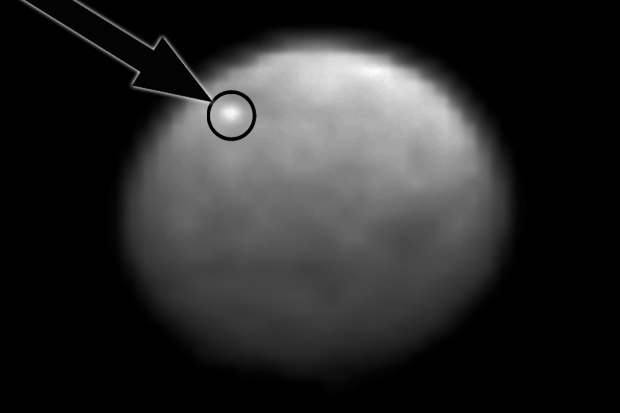NASA Finds Mysterious Bright Spot on Dwarf Planet Ceres: What Is It?

A strange, flickering white blotch found on the dwarf planet Ceres by a NASA spacecraft has scientists scratching their heads.
The white spot on Ceres in a series of new photos taken on Jan. 13 by NASA's Dawn spacecraft, which is rapidly approaching the round dwarf planet in the asteroid belt between the orbits of Mars and Jupiter. But when the initial photo release on Monday (Jan. 19), the Dawn scientists gave no indication of what the white dot might be.
"Yes, we can confirm that it is something on Ceres that reflects more sunlight, but what that is remains a mystery," Marc Rayman, mission director and chief engineer for the Dawn mission, told Space.com in an email. [Photos of Dwarf Planet Ceres]
The new images show areas of light and dark on the face of Ceres, which indicate surface features like craters. But at the moment, none of the specific features can be resolved, including the white spot.
"We do not know what the white spot is, but it's certainly intriguing," Rayman said. "In fact, it makes you want to send a spacecraft there to find out, and of course that is exactly what we are doing! So as Dawn brings Ceres into sharper focus, we will be able to see with exquisite detail what [the white spot] is."
Ceres is a unique object in our solar system. It is the largest object in the asteroid belt and is classified as an asteroid. It is simultaneously classified as a dwarf planet, and at 590 miles across (950 kilometers, or about the size of Texas), Ceres is the smallest known dwarf planet in the solar system.
The $466 million Dawn spacecraft is set to enter into orbit around Ceres on March 6. Dawn left Earth in 2007 and in the summer of 2011, it made a year-long pit stop at the asteroid Vesta, the second largest object in the asteroid belt.
Get the Space.com Newsletter
Breaking space news, the latest updates on rocket launches, skywatching events and more!
While Vesta shared many properties with our solar system's inner planets, scientists with the Dawn mission suspect that Ceres has more in common with the outer most planets. 25 percent of Ceres' mass is thought to be composed of water, which would mean the space rock contains even more fresh water than Earth. Scientists have observed water vapor plumes erupting off the surface of Ceres, which may erupt from volcano-like ice geysers.
The mysterious white spot captured by the Dawn probe is one more curious feature of this already intriguing object.
Follow Calla Cofield @callacofield. Follow us @Spacedotcom, Facebook and Google+. Original article on Space.com.
Join our Space Forums to keep talking space on the latest missions, night sky and more! And if you have a news tip, correction or comment, let us know at: community@space.com.

Calla Cofield joined Space.com's crew in October 2014. She enjoys writing about black holes, exploding stars, ripples in space-time, science in comic books, and all the mysteries of the cosmos. Prior to joining Space.com Calla worked as a freelance writer, with her work appearing in APS News, Symmetry magazine, Scientific American, Nature News, Physics World, and others. From 2010 to 2014 she was a producer for The Physics Central Podcast. Previously, Calla worked at the American Museum of Natural History in New York City (hands down the best office building ever) and SLAC National Accelerator Laboratory in California. Calla studied physics at the University of Massachusetts, Amherst and is originally from Sandy, Utah. In 2018, Calla left Space.com to join NASA's Jet Propulsion Laboratory media team where she oversees astronomy, physics, exoplanets and the Cold Atom Lab mission. She has been underground at three of the largest particle accelerators in the world and would really like to know what the heck dark matter is. Contact Calla via: E-Mail – Twitter









